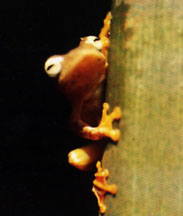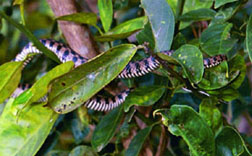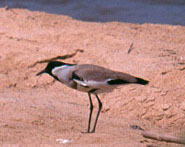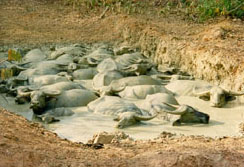VERTEBRATES
Amphibians--
 Amphibians
require water for reproduction but can live on land. Although the adults
are air breathing, the larvae have gills and can use dissolved oxygen.
Amphibians in the form of frogs and toads are a conspicuous element of
the fauna of aquatic environments, being especially abundant in marginal
vegetation and in floodplain wetlands. Other species are confined to upland
streams, or small rivers flowing through forest, or may have narrow habitat
preferences. All adult amphibians are carnivorous and feed mainly on insects
although they may also take small fish. Larvae are usually dependent on
plant food, either algae or decaying leaves, but they tend to become more
carnivorous as they develop.
Amphibians
require water for reproduction but can live on land. Although the adults
are air breathing, the larvae have gills and can use dissolved oxygen.
Amphibians in the form of frogs and toads are a conspicuous element of
the fauna of aquatic environments, being especially abundant in marginal
vegetation and in floodplain wetlands. Other species are confined to upland
streams, or small rivers flowing through forest, or may have narrow habitat
preferences. All adult amphibians are carnivorous and feed mainly on insects
although they may also take small fish. Larvae are usually dependent on
plant food, either algae or decaying leaves, but they tend to become more
carnivorous as they develop.
Many amphibians in Southeast Asia are threatened by deforestation, but
numbers are declining also for other reasons. Because these animals have
thin skin that can absorb water and excrete wastes it may be that they
are especially susceptible to pollutants, pesticides and changes in water
quality. Amphibians are also a human food source, and this makes it especially
important to investigate their current conservation status and reasons
for the apparent declines in abundance (e.g., Graham and Round 1994).
Reptiles--
Reptiles are air-breathing animals that breed on dry land. There are many
aquatic forms that specialize in eating fish and other prey, or carrion.
They include snakes, lizards, turtles and crocodilians. All  snakes
can swim, but a few are specialized for aquatic life and may have rather
specific preference for altitude or habitat type; Boiga dendrophila
(Colubridae), for example, is confined to mangroves. Snakes that grow
to only 100 cm in length, such as Enhydris, Opisthotopis and
Sinonatrix (Colubridae), probably feed mainly on fish and amphibians.
snakes
can swim, but a few are specialized for aquatic life and may have rather
specific preference for altitude or habitat type; Boiga dendrophila
(Colubridae), for example, is confined to mangroves. Snakes that grow
to only 100 cm in length, such as Enhydris, Opisthotopis and
Sinonatrix (Colubridae), probably feed mainly on fish and amphibians.
The Monitor lizards (Varanidae) include Varanus salvator that is
specialised for life in and around water. They are strong and capable
swimmers, using their tails for propulsion and defence. Varanus salvator
can exceed two metres in length; fish are important prey items but carrion
is eaten also. The Water dragon, Physignathus cocincinus (Agamidae)
is associated with riparian trees along forest streams. It is emerald
green and spectacular in appearance, reaching about 70 cm in length, and
hence is much sought after – and threatened by – the pet trade.
Crocodiles and turtles occur throughout tropical Asia, but the range and
abundance of all species has decreased in recent decades. Crocodylus
siamensis of the Mekong is a good example; it is now almost extinct
in the wild, although many are maintained in crocodile farms. Crocodiles
are considered further, in the context of biodiversity conservation, in
Section 8 on 'Threatened biodiversity in Southeast Asian river basin').
Riverine birds--
Many birds are adapted to aquatic habits, and the group includes a range
of life-styles from herbivorous species that feed on submerged macrophytes
to specialist predators upon fish. Ducks (Anatidae) are herbivores that
feed in water using one of two methods Diving ducks submerge themselves entirely when feeding and swim
for considerable distances underwater. Dabbling ducks feed from the surface,
submerging only their head and necks. Domestic ducks are abundant on areas
of river floodplain settled by humans. Waders (Scolopacidae such as Sandpipers
and Greenshanks) usually walk in shallow water or along the water margins
in places where the riverbed is sandy or muddy, and probe the substratum
with their beaks in order to obtain buried invertebrates (especially molluscs
and annelid worms). Storks (Gruidae) and Cranes (Ciconiidae) are large,
long-necked wading birds with stout beaks that were once associated with
wetlands across Southeast Asia, but most of them have declined greatly
in abundance and extent. An exception is the Asian openbill stork (Anastomis
oscitans), which is a specialist feeder on large molluscs such as
Apple snails (Pilidae) and unionid bivalves (see previous section). Specialist
fish eaters include:
methods Diving ducks submerge themselves entirely when feeding and swim
for considerable distances underwater. Dabbling ducks feed from the surface,
submerging only their head and necks. Domestic ducks are abundant on areas
of river floodplain settled by humans. Waders (Scolopacidae such as Sandpipers
and Greenshanks) usually walk in shallow water or along the water margins
in places where the riverbed is sandy or muddy, and probe the substratum
with their beaks in order to obtain buried invertebrates (especially molluscs
and annelid worms). Storks (Gruidae) and Cranes (Ciconiidae) are large,
long-necked wading birds with stout beaks that were once associated with
wetlands across Southeast Asia, but most of them have declined greatly
in abundance and extent. An exception is the Asian openbill stork (Anastomis
oscitans), which is a specialist feeder on large molluscs such as
Apple snails (Pilidae) and unionid bivalves (see previous section). Specialist
fish eaters include:
• Fish eagles (Ichthyophaga spp.) that capture fish with their feet;
• Herons and Egrets (Ardeidae) that fish (and frogs) using their beaks while wading or waiting in ambush;
• certain Kingfishers (Cerylidae and Alcedo spp: Alcedinidae) that dive from the air to capture surface-swimming fishes in their beaks;
• Cormorants (Phalacrocoracidae) that dive and swim underwater for considerable distances in pursuit of their prey. Cormorants are so efficient that some have been domesticated and are used in a specialized fishery.
• Pelicans (Pelecanidae) that dive into the water to catch fish in their large, pouched beak.
Specialist river birds are particularly diverse in Asia, where many
are threatened by a variety of human activities. This matter is considered
in more detail in Section 8 – 'Riverine Birds').
Riverine mammals--
Mammals use rivers and floodplains for drinking and grazing, and floodplains
are important grazing sites for domestic cattle and buffalo. Other  species
are more directly dependent upon the aquatic environment, as enter the
water to feed on fishes or aquatic invertebrates. Otters (Aonyx, Lutra
and Lutrogale), for example, are adapted to river life with
modified fur and skeletal structures that enable them to pursue and capture
fish under water. However, they rear their young on land. The only entirely
aquatic mammals are members of the order Cetacea, which include porpoises
and dolphins. Two cetacean species occur in the Mekong. One of them, the
Finless porpoise (Neophocaena phocaenoides) is primarily a coastal
species that also swims up rivers; it is distributed from Japan to the
Persian Gulf. River dolphins, along with many other mammals that inhabit
floodplains and riverine forest are highly endangered, and are considered
in Section 8 on mammals.
species
are more directly dependent upon the aquatic environment, as enter the
water to feed on fishes or aquatic invertebrates. Otters (Aonyx, Lutra
and Lutrogale), for example, are adapted to river life with
modified fur and skeletal structures that enable them to pursue and capture
fish under water. However, they rear their young on land. The only entirely
aquatic mammals are members of the order Cetacea, which include porpoises
and dolphins. Two cetacean species occur in the Mekong. One of them, the
Finless porpoise (Neophocaena phocaenoides) is primarily a coastal
species that also swims up rivers; it is distributed from Japan to the
Persian Gulf. River dolphins, along with many other mammals that inhabit
floodplains and riverine forest are highly endangered, and are considered
in Section 8 on mammals.